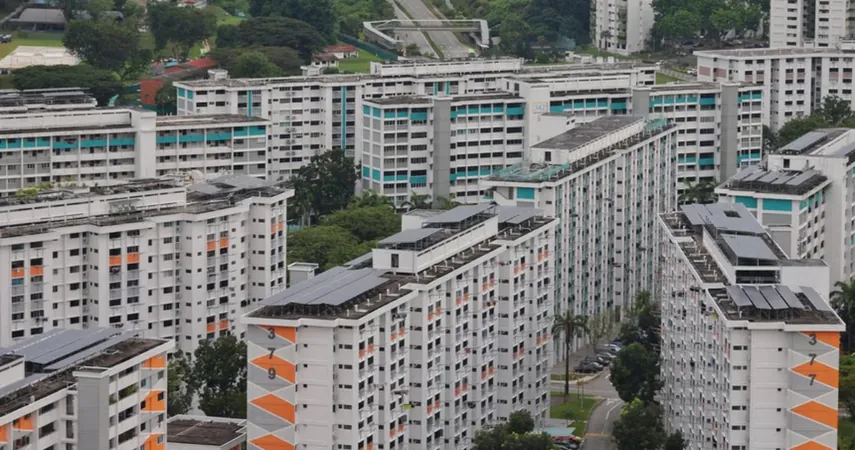
The Rise of Small Flats: Why Singles and Small Households are Driving Demand in Singapore
2024-12-30
Author: Yu
SINGAPORE — In a striking testament to evolving lifestyles, recent trends reveal a dramatic increase in the demand for smaller flats in Singapore, particularly among singles and small households. A poignant example comes from Lim, a 34-year-old IT executive who sold his three-room HDB flat in Tampines for $480,000, a staggering $10,000 over his asking price. The overwhelming interest his property garnered reflects a significant shift in the real estate landscape.
Lim's flat attracted three groups of interested buyers on its first day on the market, with the total number of viewers surpassing 10 by week’s end. This surge in demand is not an isolated incident; it indicates a broader trend affecting Singapore's housing market, notably over the past four years.
According to Christine Sun, chief researcher and strategist at OrangeTee Group, the appetite for smaller living spaces has reached new heights. From January to November 2023, there were 740 two-room flats sold, nearly double the 388 from the same timeframe in 2020. The three-room flat sales also soared by 30%, while four-room flats saw a 27.7% increase. The rise in average resale prices reflects this evolving demand, with two-room flats rising by a staggering 45.4% and three-room flats by 41% compared to 2020.
What’s driving this trend? Analysts emphasize several key factors. Firstly, many two- and three-room flats have recently reached their Minimum Occupation Period (MOP), significantly increasing supply in the market. Between 2019 and 2024, the number of two-room flats that reached MOP jumped by 234.2% to 15,462 units, while three-room flats saw a 122.9% rise, totaling 23,556 units.
Moreover, demographic shifts play a crucial role. Singapore's population is ageing, and household sizes are shrinking, with the average household size decreasing from 3.4 people in 2014 to three in 2023. Households with three or fewer members grew by 38.2% during this period, showcasing a rising trend toward smaller residences.
Real estate executives like Eugene Lim point out that the increasing cost of living has made smaller, more affordable flats appealing to many Singaporeans. Two-room flats are particularly attractive to singles, while three-room flats serve the needs of both singles and small families operating on tighter budgets. These smaller units also typically incur lower renovation costs, making them financially advantageous.
The contrast in pricing further underscores this trend. In late 2020, the median price of a two-room flat was $238,000. By the end of 2024, this figure had soared to $353,000, while three-room flats rose from $308,000 to $430,000. In comparison, four-room flats reached a median price of $615,000, further emphasizing the allure of smaller properties for budget-conscious buyers.
Older residents find themselves downsizing for various reasons, including unlocking equity to facilitate living expenses and simplifying home maintenance as mobility decreases with age. Real estate agent Susan Mariam reports that the vast majority of her HDB transactions in 2024 involved three-room flats, catering to both singles and older clients looking to reduce their living space.
Young couples are also engaging in this trend, frequently selling their larger flats post-MOP to relocate to smaller homes and alleviate financial burdens. Property inquiries for two- and three-room flats have surged, particularly from couples who anticipate small families, where a three-room flat suffices as both practical and economical.
As market trends continue to reflect a demand for smaller flats, industry experts predict that this trend may persist. However, the influx of new Build-To-Order flats could temper price growth, potentially making them an attractive alternative for buyers seeking affordable options.
With flexible purchasing policies for single people and various grants to make housing more accessible, the future of Singapore’s property market may very well belong to those who opt for smaller homes. One thing is clear: the dynamic panorama of housing in Singapore is evolving, shaped by the pressing needs of its residents.


 Brasil (PT)
Brasil (PT)
 Canada (EN)
Canada (EN)
 Chile (ES)
Chile (ES)
 España (ES)
España (ES)
 France (FR)
France (FR)
 Hong Kong (EN)
Hong Kong (EN)
 Italia (IT)
Italia (IT)
 日本 (JA)
日本 (JA)
 Magyarország (HU)
Magyarország (HU)
 Norge (NO)
Norge (NO)
 Polska (PL)
Polska (PL)
 Schweiz (DE)
Schweiz (DE)
 Singapore (EN)
Singapore (EN)
 Sverige (SV)
Sverige (SV)
 Suomi (FI)
Suomi (FI)
 Türkiye (TR)
Türkiye (TR)